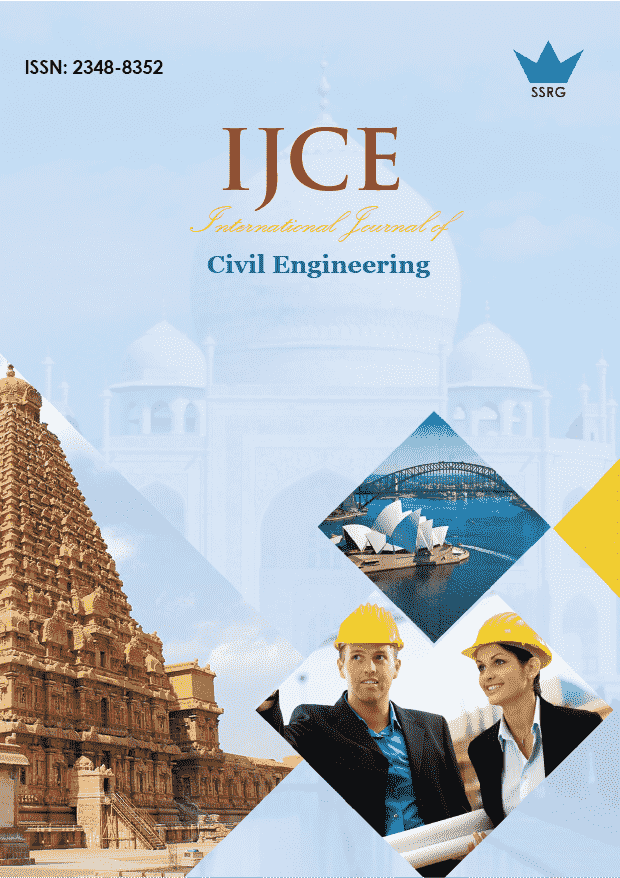Housing Heat Transport for Comfort Considerations: A Brief Review

| International Journal of Civil Engineering |
| © 2022 by SSRG - IJCE Journal |
| Volume 9 Issue 11 |
| Year of Publication : 2022 |
| Authors : Pedro Flores-Becerra, Julio Mateo-Santiago, Edgardo J. Suarez-Dominguez, Ignacio Anchondo-Perez, Mireya A. Rosas-Lusset, Evangelina A. Montalvo-Rivero |
How to Cite?
Pedro Flores-Becerra, Julio Mateo-Santiago, Edgardo J. Suarez-Dominguez, Ignacio Anchondo-Perez, Mireya A. Rosas-Lusset, Evangelina A. Montalvo-Rivero, "Housing Heat Transport for Comfort Considerations: A Brief Review," SSRG International Journal of Civil Engineering, vol. 9, no. 11, pp. 1-5, 2022. Crossref, https://doi.org/10.14445/23488352/IJCE-V9I11P101
Abstract:
Housing construction materials cause emissions in their production, and combining them is necessary for air conditioner use in a room. In many cases, environmental impact heat transfer processes are closely related to energy consumption and, therefore, city sustainability. The method of changing the interior temperature in a living space affects the comfort of users. Different criteria must consider for the study, and various equations must recognize for estimating this property. This paper corresponds to a brief review of the temperature changes through a solid corresponding to a wall or vertical or structural element exposed to a higher temperature source. It considers a cubical room and the basic process that must be considered when estimating comfort.
Keywords:
Housing comfort, Heat transport model, Room temperature.
References:
[1] Iso 7730:2005 Ergonomics of the Thermal Environment—Analytical Determination and Interpretation of the Thermal Comfort Using Calculation of the Pmv and Ppd Indices and Local Thermal Comfort Criteria (International Organization for Standardization, Geneva, Switzerland)
[2] Wang, J., et al., “Predicting Home Thermal Dynamics Using A Reduced-Order Model and Automated Real-Time Parameter Estimation,” Energy and Buildings, vol. 198, pp. 305-317, 2019. Crossref, https://doi.org/10.1016/j.enbuild.2019.06.002
[3] Laukkonen, J., et al., “Combining Climate Change Adaptation and Mitigation Measures At the Local Level,” Habitat International, vol. 33, no. 3, pp. 287-292. 2009. Crossref, https://doi.org/10.1016/j.habitatint.2008.10.003
[4] Mcmichael, A. J., et al., Climate Change and Human Health: Risks and Responses, World Health Organization, 2003.
[5] Wang, F., Yang, W. J., and Sun, W. F, “Heat Transfer and Energy Consumption of Passive House in a Severely Cold Area: Simulation Analyses,” Energies, vol. 13, no. 3, pp. 626, 2020. Crossref, https://doi.org/10.3390/en13030626
[6] Salins, S. S., et.al. “Sustainable Energy Techniques Adapted In Buildings to Regulate Moisture Transport and Enhance Thermal Comfort: A Review,” International Journal of Air-Conditioning and Refrigeration, vol. 29, no. 3, pp. 2130003. 2021. Crossref, https://doi.org/10.1142/S2010132521300032
[7] Alghamdi, S., et al., “Effect of Architectural Building Design Parameters on Thermal Comfort and Energy Consumption In Higher Education Buildings,” Buildings, vol. 12, no. 3, pp. 329, 2022. Crossref, https://doi.org/10.3390/buildings12030329
[8] Wang, R., Lu, S., and Feng, W, “A Three-Stage Optimization Methodology for Envelope Design of Passive House Considering Energy Demand, Thermal Comfort and Cost,” Energy, vol. 192, pp. 116723. 2020. Crossref, https://doi.org/10.1016/j.energy.2019.116723
[9] Escandón, R., et al., “Thermal Comfort Prediction in a Building Category: Artificial Neural Network Generation from Calibrated Models for a Social Housing Stock in Southern Europe,” Applied Thermal Engineering, vol. 150, pp. 492-505, 2019. Crossref, https://doi.org/10.1016/j.applthermaleng.2019.01.013
[10] Sarbu, I., and Dorca, A, “Review on Heat Transfer Analysis in Thermal Energy Storage Using Latent Heat Storage Systems and Phase Change Materials,” International Journal of Energy Research, vol. 43, no. 1, pp. 29-64. 2019. Crossref, https://doi.org/10.1002/er.4196
[11] Einstein, A, “On the Motion of Small Particles Suspended in Liquids at Rest Required by the Molecular-Kinetic Theory of Heat,” Annals of Physics, vol. 17, pp. 549-560, 1905. Crossref, https://doi.org/10.1002/andp.19053220806
[12] Gjerde, I. G., and Scott, L. R, “Kinetic-Energy Instability of Flows with Slip Boundary Conditions,” Journal of Mathematical Fluid Mechanics, vol. 24, no. 4, pp. 1-27. 2022. Crossref, https://doi.org/10.1007/s00021-022-00720-4
[13] Fischer, J, “The Boltzmann Constant for the Definition and Realization of the Kelvin,” Annals of Physics,vol. 531, no. 5, pp. 1800304, 2019. Crossref, https://doi.org/10.1002/andp.201800304
[14] Wu, S., et al., “Thermal Conductivity Enhancement on Phase Change Materials for Thermal Energy Storage: A Review,” Energy Storage Materials, vol. 25, pp. 251-295, 2020. Crossref, https://doi.org/10.1016/j.ensm.2019.10.010
[15] Karnati, P., Akbar, S., and Morris, P. A, “Conduction Mechanisms In One Dimensional Core-Shell Nanostructures for Gas Sensing: A Review,” Sensors and Actuators B: Chemical, vol. 295, pp. 127-143, 2019. Crossref, https://doi.org/10.1016/j.snb.2019.05.049
[16] Bai, H. Y., et al., “A Review of Heat Recovery Technologies and Their Frost Control for Residential Building Ventilation In Cold Climate Regions,” Renewable and Sustainable Energy Reviews, vol. 162, pp. 112417, 2022. Crossref, https://doi.org/10.1016/j.rser.2022.112417
[17] Hinojosa, J. F., et al., “Numerical Study of Transient and Steady-State Natural Convection and Surface Thermal Radiation in a Horizontal Square Open Cavity,” Numerical Heat Transfer, Part A, vol. 48, no. 2, pp.179-196, 2005. Crossref, https://doi.org/10.1080/10407780590948936
[18] Zhang, T., et al., “Influence of Tree Location on Thermal Radiation Disturbance of the West Wall of Summer Buildings,” Energy and Buildings, vol. 273, pp. 112359. 2022. Crossref, https://doi.org/10.1016/j.enbuild.2022.112359
[19] V. Nandhini, D. et al., “An Analysis on Low Cost and Energy Efficient Materials for Sustainable Housing," International Journal of Engineering Trends and Technology, vol. 68, no. 2, pp. 88-96, 2020. Crossref, https://doi.org/10.14445/22315381/IJETT-V68I2P215S
[20] Höppe, P. R, “ Heat Balance Modelling,” Experience, vol. 49, no. 9, pp. 741-746. 1993. Crossref, https://doi.org/10.1007/BF01923542
[21] Bouhess, H., et al., “Dynamic Simulation of an Earth-to-Air Heat Exchanger Connected to A Villa-Type House In Marrakech,” In Bs 2013, 13th International Conference of the International Building Performance Simulation Association, 2013. Crossref, https://doi.org/10.26868/25222708.2013.2512
[22] Miyazaki, T., Akisawa, A., and Kashiwagi, T. J. R. E, “The Effects of Solar Chimneys on Thermal Load Mitigation of Office Buildings Under the Japanese Climate,” Renewable Energy, vol. 31, no. 7, pp. 987-1010, 2006. Crossref, https://doi.org/10.1016/j.renene.2005.05.003
[23] Zoras, S, “A Review of Building Earth-Contact Heat Transfer,” Advances In Building Energy Research, vol. 3, no. 1, pp. 289-313, 2009. Crossref, https://doi.org/10.3763/aber.2009.0312
[24] Pérez-Sánchez, J. F., et al., “Thermal Conductivity Prediction and Comfort in Adobe Housing in Tamaulipas,” Cogent Engineering, vol. 9, no. 1, pp. 2109321, 2022. Crossref, https://doi.org/10.1080/23311916.2022.2109321

 10.14445/23488352/IJCE-V9I11P101
10.14445/23488352/IJCE-V9I11P101